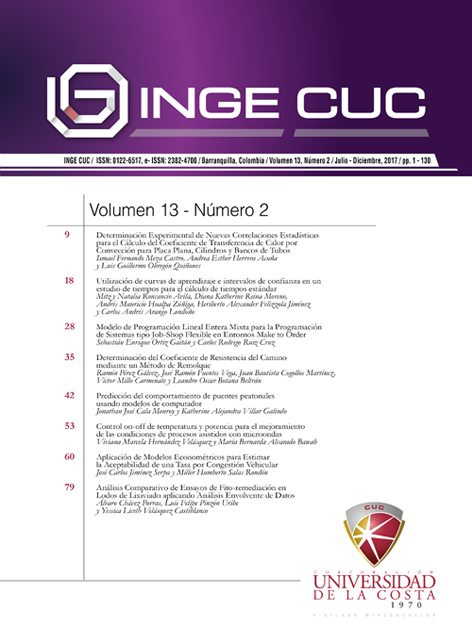Registro de neuroseñales con una Interfaz Cerebro-Computador para estimar el nivel estrés en un estudiante durante una clase
DOI:
https://doi.org/10.17981/ingecuc.13.2.2017.10Palabras clave:
Neuroseñales, estrés, clase, educación, emociones, ICCResumen
Introducción: El presente trabajo muestra un estudio de carácter individual que captura, registra y analiza el nivel de estrés de un estudiante universitario durante una clase que involucra una evaluación. La información del estrés se estimó por medio de una interfaz cerebro-computador comercial y de bajo costo. Esto permite solucionar el problema de obtener fácilmente medidas cuantitativas y no solo cualitativas.
Objetivo: Analizar el comportamiento de las neuroseñales para estimar el nivel de estrés en un estudiante ante algunos eventos verbales y no verbales generados por un docente.
Metodología: Se desarrolló un diseño experimental de carácter individual tomando como perturbaciones al nivel de estrés eventos tales como preguntas, limitaciones de tiempo y gestos.
Resultados: Se logró poner en evidencia algunos eventos que causan estrés en los estudiantes producidos por el lenguaje verbal y no verbal del docente al impartir la clase.
Conclusiones: Se recomienda a los docentes moderar su lenguaje corporal durante las evaluaciones evitando acciones que emulen afanes o presiones en tiempos innecesarios.
Descargas
Citas
[2] R. Repetti y S. Wang, “Effects of job stress on family relationships,” Curr. Opin. Psychol., vol. 13, pp. 15–18, 20. http://linkinghub.elsevier.com/retrieve/pii/S2352250X16300240
[3] A. Marchand, J. Bilodeau, A. Demers, N. Beauregard, P. Durand y V. Y. Haines, “Gendered depression: Vulnerability or exposure to work and family stressors?,” Soc. Sci. Med., vol. 166, pp. 160–168, 2016. DOI: https://doi.org/10.1016/j.socscimed.2016.08.021
[4] A. S. Masarik y R. D. Conger, “Stress and child development: A review of the Family Stress Model,” Curr. Opin. Psychol., vol. 13, pp. 85–90, 2017. http://dx.doi.org/10.1016/j.copsyc.2016.05.008
[5] A. A. Stone, S. Schneider y J. E. Broderick, “Psychological stress declines rapidly from age 50 in the United States: Yet another well-being paradox,” J. Psychosom. Res., vol. 103, 2017. http://linkinghub.elsevier.com/retrieve/pii/S0022399917309716
[6] C. Salavera, P. Usán, S. Pérez, A. Chato y R. Vera, “Differences in Happiness and Coping with Stress in Secondary Education Students,” Procedia - Soc. Behav. Sci., vol. 237, pp. 1310–1315, 2017. http://linkinghub.elsevier.com/retrieve/pii/S187704281730215X
[7] RAE, “Diccionario de la Real Academia la Lengua Española,” 2017. [En línea]. Disponible en: http://dle.rae.es/?w=estres
[8] Association American Psychological, “Los distintos tipos de Estrés,” 2017. [En línea]. Disponible en: http://www.apa.org/centrodeapoyo/tipos.aspx
[9] C. Fernández Jiménez y M. T. Polo Sánchez, “Afrontamiento, estrés y bienestar psicológico en estudiantes de educación social de nuevo ingreso,” EduPsykhé. Rev. Psicol. y Educ., vol. 10, no. 2, pp. 177–192, 2011. https://dialnet.unirioja.es/servlet/articulo?codigo=3896794
[10] T. Velásquez Pérez, E. E. Espinel Blanco y G. Guerrero Gómez, “Estrategias Pedagógicas en el aula de clase,” Rev. Colomb. Tecnol. Av., vol. 2, no. 28, pp. 124–131, 2016. http://www.unipamplona.edu.co/unipamplona/portalIG/home_40/recursos/revistas/20052017/revista_28.jsp
[11] I. S. Flórez, L. E. Mendoza y V. Pérez Ginna, “Medición automática del nivel de aprendizaje en niños de 4 a 6 años de edad aplicando técnicas de procesamiento de señales,” Rev. Colomb. Tecnol. Av., vol. 2, no. 28, pp. 93–100, 2016. http://www.unipamplona.edu.co/unipamplona/portalIG/home_40/recursos/revistas/20052017/revista_28.jsp
[12] J. Katona, I. Farkas, P. Ujbanyi, A. Dukan y A. Kovari, “Evaluation of the NeuroSky MindFlex EEG headset brain waves data,” in IEEE 12th International Symposium on Applied Machine Intelligence and Informatics (SAMI), pp. 91–94, 2014. http://ieeexplore.ieee.org/document/6822382/
[13] A. Fernández y M. Eid, “Read Go Go!: Towards real-time notification on readers’ state of attention,” in XXIV International Symposium on Information, Communication and Automation Technologies (ICAT), pp. 1–6, 2013. http://ieeexplore.ieee.org/document/6684047/
[14] W. A. Dijk, W. van der Velde, W. J. M. Kolkman, H. J. G. M. Crijns y K. I. Lie, “Integration of the Marquette ECG management system into the Department Information System using the European SCP-ECG Standard,” Computers in Cardiology, 1995. [En línea]. Disponible en: http://ieeexplore.ieee.org/document/482669/
[15] L. Moreno, C. Peña y H. González, “Integración de un sistema de neuroseñales para detectar expresiones en el análisis de material multimedia,” Rev. Fac. Ing., vol. 24, no. 38, pp. 29–40, 2014. http://revistas.uptc.edu.co/index.php/ingenieria/article/view/3156/4343
[16] F. M. Córdova, H. Díaz M., F. Cifuentes L. Cañete y F. Palominos, “Identifying problem solving strategies for learning styles in engineering students subjected to intelligence test and EEG monitoring,” Procedia Comput.Sci., vol. 55, pp. 18–27, ITQM, 2015. Disponible en: https://ac.els-cdn.com/S1877050915014787/1-s2.0-S1877050915014787-main.pdf?_tid=1bd56790-d3b4-11e7-9b67-00000aab0f02&acdnat=1511815797_d51e4bc601e18e4ce25f62ab7eacedb0
[17] J. F. Rubiano, C. A. Peña y E. Martínez, “Avance en el desarrollo de una plataforma de control metal de un robot paralelo tipo Delta,” in VII Congreso Bolivariano de Ingenieria Mecanica, 2012. http://congreso.pucp.edu.pe/vii-cobim/H.1.11.pdf
[18] B. Nakisa, M. N. Rastgoo, D. Tjondronegoro y V. Chandran, “Evolutionary Computation Algorithms for Feature Selection of EEG-based Emotion Recognition using Mobile Sensors,” Expert Syst. Appl., 2017. DOI: http://dx.doi.org/10.1016/j.eswa.2017.09
[19] T. H. E. Science, “Open Your Mind to Next Generation Brainwe EMOTIV Insight Introduction Vid,” 2017. [En línea]. Disponible en: https://www.emotiv.com/insight/HARDWARE
[20] C. Peña, S. Caicedo, L. U. Z. Moreno, M. Maestre y A. Pardo, “Use of a Low Cost Neurosignals Capture System to Show the Importance of Developing Didactic Activities Within a Class to Increase the Level of Student Engagement (Case Study),” WSEAS Trans. Comput., vol. 16, pp. 172–178, 2017. http://www.wseas.org/multimedia/journals/computers/2017/a385905-070.php
[21] C. A. Peña Cortés, O. E. Gualdrón y G. G. Moreno Contreras, “Warning and Rehabilitation System Using Brain Computer Interface (BCI) in Cases of Bruxism,” Ing. y Univ., vol. 18, no. 1, pp. 177–193, 2014. DOI: http://dx.doi.org/10.11144/Javeriana.IYU18-1.sarb
[22] M. Soler, H. Rodríguez y C. Peña, “Desarrollo de un robot explorador operado mediante neuroseñales,” Rev. Politécnica, vol. 10, no. 19, pp. 125–134, 2014. http://revistas.elpoli.edu.co/index.php/pol/article/view/479
Descargas
Publicado
Cómo citar
Número
Sección
Licencia
Los artículos publicados son de exclusiva responsabilidad de sus autores y no reflejan necesariamente las opiniones del comité editorial.
La Revista INGE CUC respeta los derechos morales de sus autores, los cuales ceden al comité editorial los derechos patrimoniales del material publicado. A su vez, los autores informan que el presente trabajo es inédito y no ha sido publicado anteriormente.
Todos los artículos están bajo una Licencia Creative Commons Atribución-NoComercial-SinDerivadas 4.0 Internacional.



 English
English
 Español (España)
Español (España)























